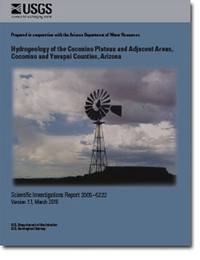Hydrogeology of the Coconino Plateau and adjacent areas, Coconino and Yavapai Counties, Arizona
Links
- More information: USGS Index Page (html)
- Document: Report (7.9 MB pdf)
- Plates:
- Download citation as: RIS | Dublin Core
Abstract
Two large, regional ground-water flow systems occur in the Coconino Plateau and adjacent areas: the C aquifer and the Redwall-Muav aquifer. The C aquifer occurs mainly in the eastern and southern parts of the 10,300-square-mile Coconino Plateau study area, and the Redwall-Muav aquifer underlies the entire study area. The C aquifer is a water-table aquifer for most of its occurrence with depths to water that range from a few hundred feet to more than 1,500 feet. In the western part of the Coconino Plateau study area, the C aquifer is dry except for small localized perched water-bearing zones decoupled from the C aquifer to the east. The Redwall-Muav aquifer underlies the C aquifer and ranges from at least 3,000 feet below land surface in the western part of the Coconino Plateau study area to more than 3,200 feet below land surface in the eastern part of the study area. The Redwall-Muav aquifer is a confined aquifer for most of its occurrence with hydraulic heads of several hundred to more than 500 feet above the top of the aquifer in the western part of the study area and more than 2,000 feet above the top of the aquifer in the eastern part of the study area near Flagstaff. In the eastern and northeast parts of the area, the C aquifer and the Redwall-Muav aquifer are in partial hydraulic connection through faults and other fractures. The water discharging from the two aquifers on the Coconino Plateau study area is generally of good quality for most intended uses. Water from sites in the lower Little Colorado River Canyon had high concentrations of most trace elements relative to other springs, rivers, and streams in the study area. Concentrations of barium, arsenic, uranium, and lead, and gross alpha radioactivity were greater than U.S. Environmental Protection Agency Maximum Contaminant Levels for drinking water at some sites. Ground water discharging to most springs, streams, and wells on the Coconino Plateau and in adjacent areas is a calcium magnesium bicarbonate type and has low concentrations of the major dissolved constituents. Ground water discharging from the Redwall-Muav aquifer to springs in the lower Little Colorado River Canyon is a mixture of water from the C aquifer and the Redwall-Muav aquifer and is a sodium chloride type with high concentrations of most major dissolved constituents. Concentrations of sulfate and chloride in ground water discharging from the Redwall-Muav aquifer at springs near the south rim of Grand Canyon increase toward the west. Water samples from the Verde River above Mormon Pocket had higher concentrations of most dissolved constituents than samples from springs that discharge from the Redwall-Muav aquifer at Mormon Pocket and in Sycamore Canyon. Water-chemistry data from C aquifer wells and springs in the Flagstaff area indicate that ground-water ages in the aquifer range from 7,000 years to modern and that samples were a mix of younger and older waters. Ground-water ages for the Redwall-Muav aquifer are estimated to range from 22,600 to 7,500 years, and low tritium values indicate that this water is older than water discharging from the C aquifer. Tritium and carbon-14 results indicate that ground water discharging at most springs and streams is a mixture of young and old ground waters, likely resulting from multiple flow paths and multiple recharge areas. Ground-water withdrawals in the study area increased from about 4,000 acre-feet per year prior to 1975, to about 20,000 acre-feet per year in 2003. About two-thirds of the water withdrawn is from the C aquifer and about one-third is from the Redwall-Muav aquifer. In the study area, most development of the C aquifer has occurred near Flagstaff. Development of the Redwall-Muav aquifer is more extensive in Verde Valley where water-bearing zones of the aquifer are closer to land surface. In recent years, however, development of the Redwall-Muav aquifer in the study area has increased in response to population growth and the atten
Suggested Citation
Bills, D., Flynn, M., Monroe, S.A., 2007, Hydrogeology of the Coconino Plateau and adjacent areas, Coconino and Yavapai Counties, Arizona (Version 1.0: Originally posted 2007; Version 1.1: March 2016): U.S. Geological Survey Scientific Investigations Report 2005-5222, Report: xi, 101 p.; 4 Plates: 30.88 x 31.88 inches or smaller, https://doi.org/10.3133/sir20055222.
ISSN: 2328-0328 (online)
Study Area
Table of Contents
- Abstract
- Introduction
- Hydrogeology
- Water Chemistry
- Conceptual Model of the Ground-Water Flow Systems
- Considerations for Additional Data Collection and Monitoring
- Summary and Conclusions
- References Cited
- Supplemental Data
| Publication type | Report |
|---|---|
| Publication Subtype | USGS Numbered Series |
| Title | Hydrogeology of the Coconino Plateau and adjacent areas, Coconino and Yavapai Counties, Arizona |
| Series title | Scientific Investigations Report |
| Series number | 2005-5222 |
| DOI | 10.3133/sir20055222 |
| Edition | Version 1.0: Originally posted 2007; Version 1.1: March 2016 |
| Year Published | 2007 |
| Language | English |
| Publisher | U.S. Geological Survey |
| Contributing office(s) | Arizona Water Science Center |
| Description | Report: xi, 101 p.; 4 Plates: 30.88 x 31.88 inches or smaller |
| Online Only (Y/N) | Y |
| Additional Online Files (Y/N) | Y |


